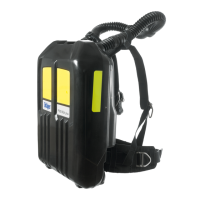
Do you have a question about the Dräger PSS BG 4 plus and is the answer not in the manual?
| Type | Closed-circuit breathing apparatus |
|---|---|
| Air Supply | Compressed air |
| Oxygen Cylinder Capacity | 4 liters |
| Operating Pressure | 200 bar |
| Duration | up to 4 hours |
| Breathing Gas | Air |
| Maximum Operating Depth | 40 meters |
| Usage | Firefighting, rescue operations |
| Weight | Approx. 15 kg (ready to use) |
Read and strictly follow all instructions for use and associated product instructions for safe operation.
Defines DANGER, WARNING, CAUTION, and NOTICE icons used to highlight critical information for user awareness.
Provides a detailed overview and illustrations of the closed-circuit breathing apparatus and its Sentinel component.
Explains how the closed-circuit breathing apparatus and its electronic monitoring system operate.
Specifies that the apparatus supplies breathing air for approx. 4 hours for fire services and mining operations.
Outlines general and specific cautions, limitations, and restrictions related to the usage period of the apparatus.
Lists the approvals and standards the closed-circuit breathing apparatus and Sentinel meet, including DIN EN 145 and NIOSH.
Explains symbols and type-identifying marks displayed on the Sentinel and the apparatus.
Lists necessary checks and conditions before using the apparatus, including protective gear and regulations.
Details the steps for initial inspection and testing of the closed-circuit breathing apparatus before its first use.
Guides users through the steps required to prepare the apparatus for use, including fitting components and initial tests.
Provides instructions on how to correctly fit and secure the compressed oxygen cylinder into the apparatus.
Explains how to prepare and insert an ice pack into the breathing air cooler for temperature reduction.
Details the procedure for testing the correct functioning of the apparatus using the Sentinel display.
Provides step-by-step instructions on how to correctly put on and secure the closed-circuit breathing apparatus.
Offers general instructions, emergency procedures, and alarm switching for during apparatus use.
Outlines the steps for safely removing and preparing the apparatus for servicing after use.
Specifies the recommended intervals and work to be done for the maintenance of various components.
Details the systematic process for disassembling the apparatus, listing components to be removed.
Explains how to remove and test the pressure relief valve, including checking O-rings and valve disks.
Guides the user through the process of removing the breathing air cooler and its associated parts.
Describes the procedure for removing the lever, including lifting the safety knob.
Details the steps for removing the breathing bag, drain valve, minimum valve, and water absorber.
Explains how to remove the switch box from its holder using a slotted screwdriver.
Provides instructions on how to disassemble the waist belt and shoulder straps for cleaning or replacement.
Describes the method for unfastening plug-in connectors on medium-pressure hoses using a specific tool.
Outlines procedures for cleaning and disinfecting parts that contact exhaled air and other parts as needed.
Provides specific cleaning and disinfecting steps for users in the USA.
Offers cleaning and disinfecting procedures tailored for users outside the USA.
Guides the user through the process of reassembling the apparatus after disassembly.
Details how to fit the minimum valve, including checking for dryness and secure connection.
Explains how to attach the pressure plate and slide the breathing bag into the apparatus.
Describes how to position and fasten the breathing air cooler using the tensioning bar.
Guides the connection of the medium-pressure hose for the constant metering valve.
Details the assembly of the connecting piece, including fitting valve disks and examining O-rings.
Provides instructions for fitting the breathing hoses, ensuring they are not twisted and secured with safety loops.
Describes how to perform leak-tightness and functional tests using the RZ7000 test unit.
Outlines the initial steps for preparing the test unit and apparatus for testing.
Details how to test the low-pressure warning activation point using the test unit.
Explains the procedure to check the inhalation valve's function and pressure threshold.
Describes how to test the exhalation valve's function and pressure threshold.
Guides the user through testing the drain valve's opening pressure range.
Details the procedure for performing a leak test with positive pressure and checking pressure stability.
Explains how to check the relief valve's opening pressure.
Outlines the optional procedure for performing a high-pressure leak test.
Describes how to test the constant metering valve and bypass valve for correct function.
Details the procedure for checking the minimum valve's opening pressure.
Explains how to check the residual pressure warning functionality and trigger points.
Provides instructions for safely inserting or replacing the Sentinel battery.
Outlines how to test the Sentinel's functional capability without opening the cylinder valve.
Explains the steps involved in the Sentinel's self-test sequence, including interface, battery, and leak tests.
Details the procedure for removing and installing the pressure reducer component.
Shows the approval label detailing respirator configurations, limitations, and cautions.
